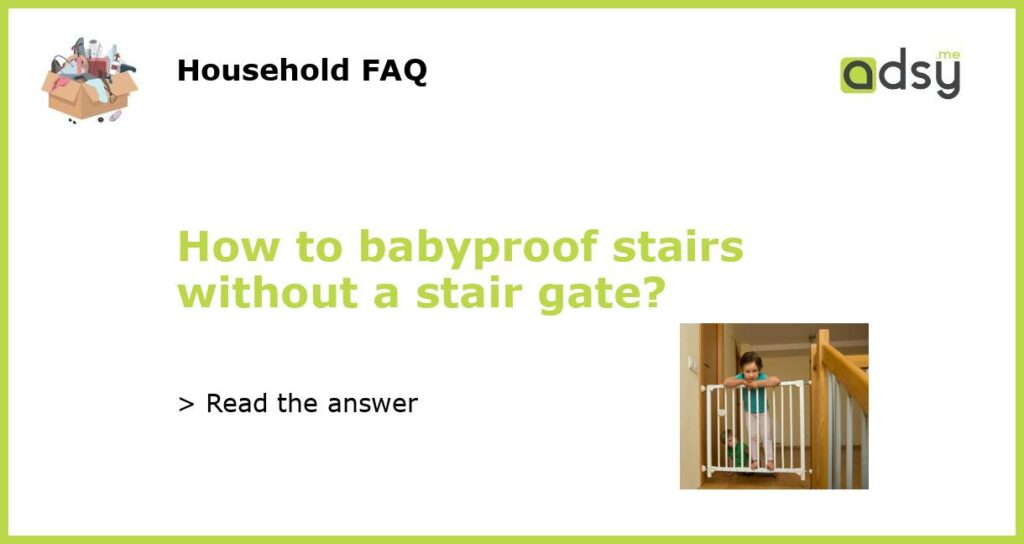Installing a DIY Barrier
When it comes to babyproofing stairs without a stair gate, one option is to install a DIY barrier. This involves creating a physical barrier that prevents your baby from accessing the stairs independently. Here’s how you can do it:
First, assess the area and determine the best location for the barrier. It should be placed at the bottom or top of the stairs, depending on your preference. Measure the width of the staircase to ensure the barrier will fit properly.
Next, gather the necessary materials. You will need a large piece of sturdy fabric or netting, wooden dowels or PVC pipes, and zip ties or strong adhesive hooks.
Measure and cut the fabric or netting to the desired height and width, leaving a little extra on each side. Attach the fabric or netting to the dowels or pipes using zip ties or adhesive hooks. Make sure the barrier is securely attached and stable.
Finally, position the barrier in place at the bottom or top of the stairs. If using zip ties or adhesive hooks, secure them tightly to ensure the barrier stays in place. Regularly check the barrier for any signs of wear or damage and make any necessary repairs to maintain its effectiveness.
Creating a Visual Barrier
An alternative to a physical barrier is creating a visual barrier that deter your baby from accessing the stairs. This method relies on visual cues to communicate that the stairs are off-limits. Here’s how you can create a visual barrier:
Start by placing colorful tape or stickers along the edge of each step. The contrasting colors will draw your baby’s attention and signal that the stairs are not safe to climb.
You can also use removable decals or large stickers to create a pattern or image on the staircase. This can serve as a visual deterrent and make the stairs appear more “off-limits” to your baby.
Another effective visual barrier is installing a temporary baby gate or screen door at the entrance to the staircase. This will create a physical barrier that your baby can’t get through, while also providing a clear visual cue that the stairs are out of bounds.
Regularly reinforce the visual barrier by reminding your baby with verbal cues that the stairs are not for climbing. Over time, your baby will learn to associate the visual cues with the concept of “no stairs.”
Rearranging Furniture
If you’re looking for a non-permanent solution, rearranging furniture can help babyproof stairs without a stair gate. By positioning furniture strategically, you can create a physical barrier that prevents your baby from accessing the stairs. Here’s how:
Identify large, sturdy pieces of furniture that can be placed strategically to block access to the stairs. This could include bookcases, sofas, or entertainment centers.
Position the furniture perpendicular to the stairs, creating a physical barrier that your baby can’t easily climb over or crawl under.
Ensure the furniture is securely in place and won’t tip over if your baby leans or pushes against it. Use wall anchors or brackets if necessary to secure heavy furniture to the wall.
Regularly check the furniture for stability and make any adjustments as needed. It’s important to ensure that the furniture barrier remains secure and cannot be easily moved by your baby.
Supervising and Teaching Safety
While physical barriers and visual cues are effective in babyproofing stairs, it’s also important to supervise your baby and teach them about stair safety. Here are some tips:
Never leave your baby unattended near the stairs, even if you have implemented other babyproofing measures. Accidents can happen quickly, and it’s vital to supervise your baby at all times when around stairs.
Teach your baby to safely navigate stairs by guiding them with your hand on their back or holding their hand. This helps them develop balance and coordination while using the stairs.
Practice going up and down the stairs together, demonstrating safe techniques and emphasizing the importance of holding onto the handrail.
Encourage your baby to crawl or walk carefully on the stairs, gradually increasing their independence as they grow older and more capable.
Consistently reinforce the rules and boundaries around stair safety, using clear and age-appropriate language to communicate the dangers and expectations.
Consulting with Professionals
If you’re unsure about the best approach to babyproofing your stairs without a stair gate, consider consulting with professionals who specialize in childproofing and safety. They can provide expert advice and guidance tailored to your specific needs and home layout.
A professional childproofing service can assess your staircase and recommend the most effective solutions, taking into account factors such as your child’s age and development, any mobility limitations, and the design of your staircase.
Additionally, professional childproofers often have access to specialized safety products and equipment that may not be readily available to the general public. They can help you source and install high-quality babyproofing solutions that meet safety standards and regulations.
By consulting with professionals, you can ensure that your babyproofing efforts are comprehensive and effective, providing a safe environment for your baby to explore and grow in.






